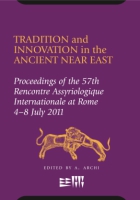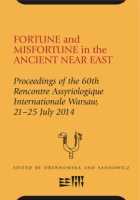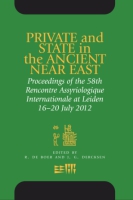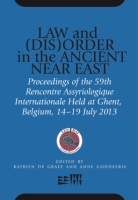
Ur in the Twenty-First Century CE
Proceedings of the 62nd Rencontre Assyriologique Internationale at Philadelphia, July 11–15, 2016
Edited by Grant Frame, Joshua Jeffers, and Holly Pittman
Ur in the Twenty-First Century CE
Proceedings of the 62nd Rencontre Assyriologique Internationale at Philadelphia, July 11–15, 2016
Edited by Grant Frame, Joshua Jeffers, and Holly Pittman
The city of Ur—now modern Tell el-Muqayyar in southern Iraq, also called Ur of the Chaldees in the Bible—was one of the most important Sumerian cities in Mesopotamia during the Early Dynastic Period in the first half of the third millennium BCE. The city is known for its impressive wealth and artistic achievements, evidenced by the richly decorated objects found in the so-called Royal Cemetery, which was excavated by the British Museum and the University of Pennsylvania from 1922 until 1934. Ur was also the cult center of the moon god, and during the twenty-first century BCE, it was the capital of southern Mesopotamia.
- Description
- Bio
- Table of Contents
- Sample Chapters
With contributions from both established and rising Assyriologists from ten countries and edited by three leading scholars of Assyriology, this volume presents thirty-two essays based on papers delivered at the 62nd Rencontre Assyriologique Internationale held in Philadelphia in 2016. Reflecting on the theme “Ur in the Twenty-First Century CE,” the chapters deal with archaeological, artistic, cultural, economic, historical, and textual matters connected to the ancient city of Ur. Three of the chapters are based on plenary lectures by senior scholars Richard Zettler, Jonathan Taylor, and Katrien De Graef. The remainder of the essays, arranged alphabetically by author, highlight innovative new directions for research and represent a diverse array of topics related to Ur in various periods of Mesopotamian history. Tightly focused in theme, yet broad in scope, this collection will be of interest to Assyriologists and archaeologists working on Iraq.
Grant Frame is Professor Emeritus of Assyriology and former Director of the Center for Ancient Studies at the University of Pennsylvania; Curator of the Penn Museum’s Babylonian Collection; and founder, Director, and Editor-in-Chief of the Royal Inscriptions of the Neo-Assyrian Period Project. He is the author of The Archive of Mušēzib-Marduk, Son of Kiribtu and Descendant of Sîn-nāṣir: A Landowner and Property Developer at Uruk in the Seventh Century BC and Rulers of Babylonia: From the Second Dynasty of Isin to the End of Assyrian Domination (1157–612 BC).
Joshua Jeffers is Lecturer in Akkadian Language at the University of Pennsylvania and Research Specialist for the Royal Inscriptions of the Neo-Assyrian Period Project. He is the coauthor of The Royal Inscriptions of Ashurbanipal (668–631 BC), Assur-etal-ilani (630–627 BC), and Sin-sarra-iskun (626–612 BC), Kings of Assyria, also published by Eisenbrauns.
Holly Pittman is Bok Family Professor in the Humanities at the University of Pennsylvania and Curator in the Near East Section and Deputy Director for Academic Programs at the Penn Museum. She is the author of Art of the Bronze Age: Southeastern Iran, Western Central Asia and the Indus Valley and coauthor of Worlds Together, Worlds Apart, fifth edition.
Foreword
Abbreviations
Program
Welcome to Participants of the 62nd Rencontre Assyriologique
Grant Frame
Plenary Papers
Woolley’s Excavations at Ur: New Perspectives from Artifact Inventories, Field Records, and Archival Documentation
Richard L. Zettler
Sîn-City: New Light from Old Excavations at Ur
Jonathan Taylor
Bad Moon Rising: The Changing Fortunes of Early Second-Millennium BCE Ur
Katrien De Graef
Conference Papers (Alphabetical by Author)
The Moon Watching Over the Sun and Venus: Revisiting the Attributes and Functions of Nanna/S.n in Mesopotamia
Isabel Gomes de Almeida & Maria de Fátima Rosa
Detecting Social Tensions in the Archaeological Record: Official and Vernacular Figurine-Making Traditions at Ur in the First Millennium BCE
Anastasia Amrhein
Old Babylonian Terracottas from Ur: Ancient and New Perspectives
Laura Battini
The City of Ur and the Neo-Babylonian Empire
Paul-Alain Beaulieu
The Ziqqurats of Ur and Babylon and the Place Where the Ark Moors After the Flood (The Epic of Gilgameš XI 158)
Daniel Bodi
Epigraphy of Ur: Past, Present, and Future
Dominique Charpin
Signs from Silence: Ur of the First Sumerians (Late Uruk Through ED I)
Petr Charvát
Breakers and Enforcers of the Oath of the King
Laura Culbertson
Utopic and Dystopic Images in Mesopotamian Literature: The Conflict Between Order and Chaos in Ur III
Maria de Fátima Rosa & Isabel Gomes de Almeida
In Search of Ur in iqqur īpuš
Jeanette C. Fincke
The Kingdom as Sheepfold: Frontier Strategy Under the Third Dynasty of Ur; A View from the Center
Steven J. Garfinkle
From Uruk to Ur: Automated Matching of Virtual Tablet Fragments
Erlend Gehlken, Tim Collins, Sandra Woolley, Laurence Hanes, Andrew Lewis, Luis Hernandez-Munoz, and Eugene Ch’ng
The City of Ur: The Possibilities for Statistical Analysis on the Use of Space in Domestic Households
Nicole Grunert
Trace Elements and Isotopes: The Origin of Gold from Ur from a Geochemical Point of View
Moritz Jansen, Andreas Hauptmann, Sabine Klein, and Richard L. Zettler
Science and Technology: Using Ur-Online to Aid in Scientific Analysis
Kyra Kaercher and Tessa de Alarcon
Towards Archival Reconstruction of Ur III Cuneiform Tablets
Yudong Liu and James Hearne
Excavating Ur in Children’s Literature
Kevin M. McGeough and Elizabeth A. Galway
Aspekte der Sklaverei im altbabylonischen Ur: Untersuchungen zu den a-ru-a-Texten
Christin Möllenbeck
Glyptic Art from the Ur III to the Šimaški Periods: Heritage and Overtaking of the Models
Clélia Paladre
The Status of Real Estate in Neo-Babylonian Ur: The Case of the Gallābu Family
Olga V. Popova
Palace and “Private” Sectors in Old Babylonian Ur
Mitchell S. Rothman
Materiality and Mark-Making: Sealing and Community in Early Dynastic Ur
Sarah J. Scott
Eclipse of a King: A New Interpretation of the Bull-Headed Lyre
JoAnn Scurlock
Local and Imported Religion at Ur Late in the Reign of Shulgi
Tonia M. Sharlach
The Third Millennium Banquet Scene at Ur and Its Archaeological Correlates
Diana L. Stein
New Excavations at Ur
Elizabeth C. Stone, Paul Zimansky, Katheryn Twiss, Michael Charles, and Melina Seabrook
Ur and Other Cities in Some Sumerian and Akkadian Personal Names: The Pre-Sargonic and Sargonic Periods
Jan Tavernier
Implications of Intertextuality: Erra and Išum and the Lamentation Over the Destruction of Sumer and Ur
Selena Wisnom
Was the Karzida of Ur’s Akītu Festival at Tell Sakhariya?
Paul Zimansky
Download a PDF sample chapter here: Introduction
Mailing List
Subscribe to our mailing list and be notified about new titles, journals and catalogs.












